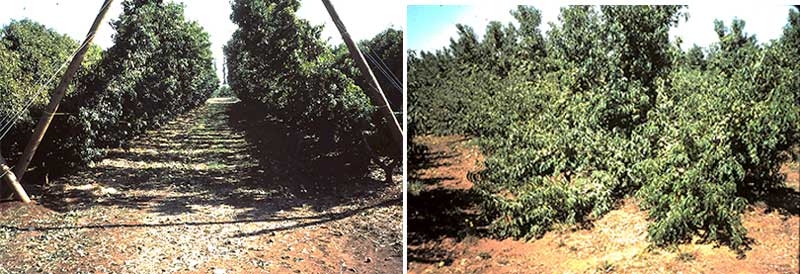National and international recognition: The Productivity Promotion Council of Australia presented team members with an award for their contribution to efficient fruit production, and an award for a method of producing peach trees from cuttings to enable orchardists to grow their own peach trees quickly and cheaply.
(Continued from last issue)
The American Society for Horticultural Science presented the 1979 Stark Award to three team members for the best paper on methods of improving fruit tree production.
Economic analyses
The high cost of establishing and maintaining a Tatura Trellis orchard was often highlighted and/or criticised.
Many economic analyses were developed—all were different, and all were ignored by orchardists. The visual results were more convincing than the hypothetical assumptions.
National & international visitors
Several overseas scientists spent short periods or their sabbatical leave working on projects that were directly linked to the Tatura system, including mechanisation.
Their participation further boosted our research, confidence and morale.
About 2000 visitors were shown around annually from Australia and 37 countries. Their visits and communications were often a measure of how far and wide the Tatura system had progressed.
More than a tree training system
A number of climatic events, and reports from New Zealand and the USA, added a significant feature to the Tatura system of growing fruit.
Peach trees on Tatura Trellis survive storms
In February 1983 a severe storm brought gale-force winds, dust, lightning, hail and rain to the area around Tatura. At the Research Station, a caravan with scientific equipment to record data in the field, was hurled 400 m over fences and came to rest in a neighbour’s field.
In and around the Station power lines were brought down, roofing was blown off houses and sheds, and fruit trees were broken and uprooted.
To our surprise, the original Tatura Trellis with peach trees planted in 1973 came through the storm unscathed, although a considerable amount of fruit, only three weeks from being harvested, was lost.
Tatura Trellis minimises wind damage to kiwifruit
Three New Zealand scientists published an article in the New Zealand Journal of Agricultural Research titled, Wind damage to kiwifruit in relation to windbreak performance.
They reported that kiwifruit vines trellised on T-bar and Pergola, and with natural or artificial windbreaks, lost an average of 25 per cent of fruit each year due to wind damage. Losses resulted from friction marks caused by fruit rubbing against each other and against plant canes.
The proportion of damage to leaves and vegetative growth was similar to fruit damage by wind-rub.
Regardless of the mechanisms involved, the high loss of exportable fruit and damage to vines meant that alternative approaches to vine protection needed to be considered.
The authors suggested that one such alternative was the Tatura Trellis because vines grown on this system with minimal internal shelter lost only one per cent of total fruit weight from wind damage.
They attributed this to canes being grown between wire supports, rather than being unsupported above the crop as on T-bar and Pergola and; a more effective reduction in the turbulent energy exchange between the vines and the overhead airstream.
V-systems in the USA (Continued from last issue)
See this article in Tree Fruit Nov 2019






















